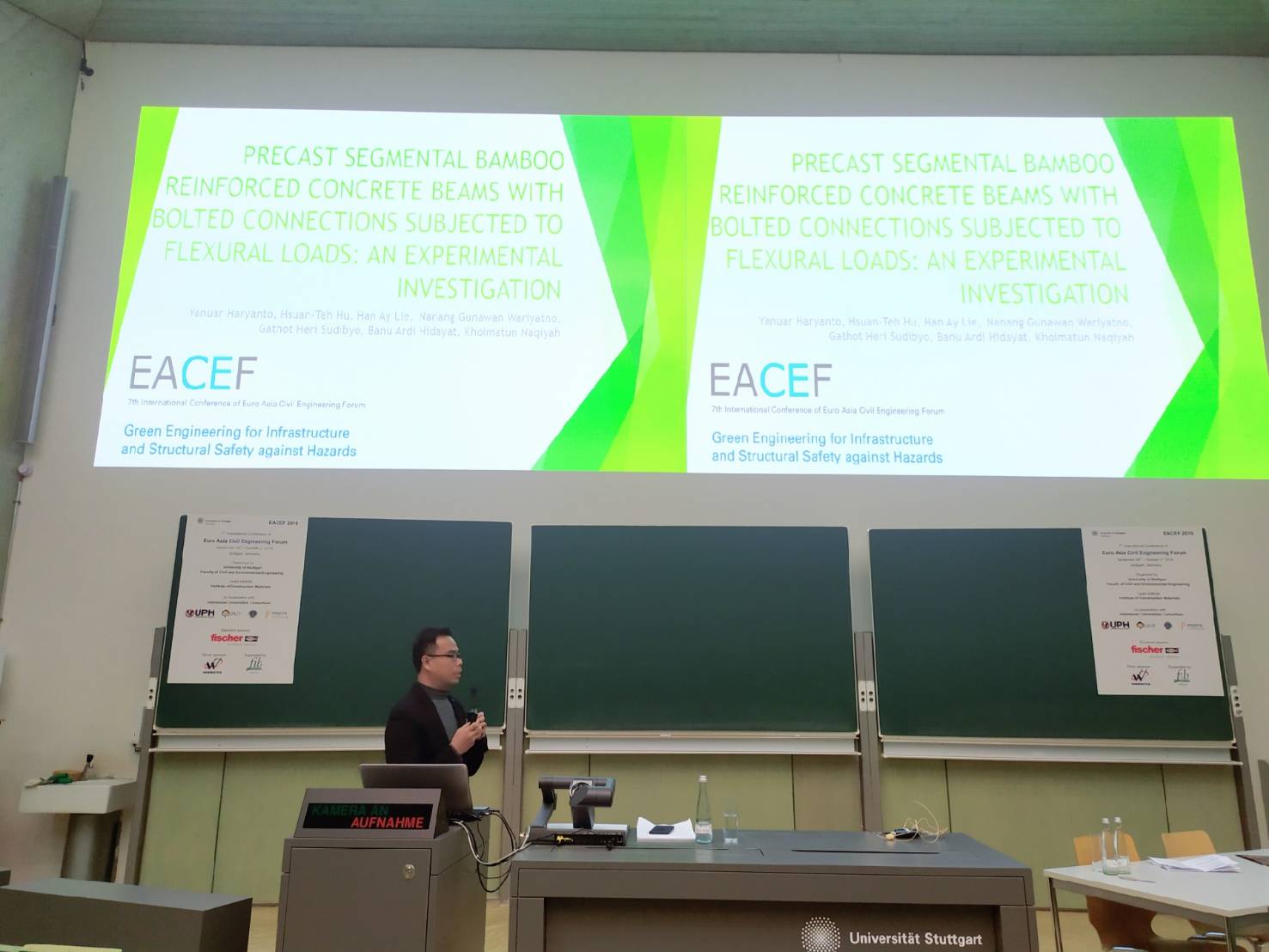

¡@

the 7th International Conference of Euro Asia Civil Engineering Forum
University of Stuttgart, German, September 30 - October 2, 2019
¡@
|
Name |
Yanuar Haryanto |
|
Education |
B.S., Department of Civil
Engineering, Sebelas Maret University,
Indonesia, 2004. Ph.D., Department of Civil Engineering, National Cheng Kung University, 2022. |
|
|
|
|
Title of Ph.D. Thesis |
Negative Moment Region Flexural Strengthening of RC T-beams Using NSM-CFRP Rods with Different Embedment Depth: Numerical, Analytical, and Experimental Investigations |
|
Abstract of Thesis |
This thesis is divided into four sections. Each section contains a number of research items related to the structural issue to be studied. Although the logical sequence was retained in the thesis, each section was organized to discuss and address a specific topic concerning the strengthening of reinforced concrete (RC) T-beams with fiber-reinforced polymer (FRP). In general, the thesis examines the application of near surface mounted (NSM) technique with various embedment depths of carbon-FRP (CFRP) rods for strengthening specimens in the negative moment region through numerical, analytical, and experimental investigation. In summary, numerical models based on finite element (FE) method as well as analytical approaches were built and/or implemented in some portions depending on their significance and necessity, based on previous studies carried out by other researchers. The experimental program of this thesis consisted of six beams with a 2.6-m length each: three beams were subjected to monotonic loading, while the remaining three beams were subjected to low reversed cyclic loading. The first section investigates the development of a comprehensive nonlinear three-dimensional FE model using ABAQUS software to accurately replicate direct pull-out tests using a double shear lap technique. The goal was to adequately define the bond mechanics between concrete and CFRP rods, with a particular emphasis on simulating the interface behavior observed between NSM-CFRP rods and concrete by adjustment of the contact interaction behavior. Overall, the effect of CFRP rod embedment depth was also taken into account. Based on the findings, the perfect bond model was found to produce a prediction for failure load that was somewhat accurate but had a higher stiffness. The use of the cohesive contact behavior to represent the surface interaction between concrete and CFRP rod resulted in simulations that were consistent with the experimental curves in terms of trend. The proposed model, on the other hand, is capable of expressing the relationship between the penalty stiffness parameters in the shear direction and the embedment depth of CFRP rods. The second section introduces a numerical investigation of the response of RC T-beams strengthened in the negative moment area using NSM-CFRP rods embedded at various depths and CFRP sheets as shear strengthening under three-point bending loading. The model took into account the contact interaction between the surrounding materials and the CFRP rod by utilizing the cohesive behavior from the first section, the nonlinearities in the compression and tension of the concrete material, the yielding ability of the steel reinforcement, and the linearly elastic behavior of the CFRP rod. It was then utilized to determine the ultimate load, which was validated by comparing numerical (FE) simulations to equivalent experimental findings from the literature. Generally, the predicted FE mid-span deflection responses agreed well with the corresponding measured experimental tested data at all stages of flexural loading. The validated FE models were then used to study the effect of different CFRP material properties to provide further information over the limited available experimental data. It was concluded that the developed FE model is suitable as a practical and economical tool especially in design-oriented parametric studies for accurate modeling and analysis of flexural negative moment strengthening of RC members with NSM-CFRP rods. The third section describes an analytical approach used in numerous models based on the Modified Compression Field Theory (MCFT) to investigate the flexural behavior of T-section RC beams strengthened in the negative moment region utilizing the NSM technique with half-embedded CFRP rods. Validation of the proposed model was confirmed first by making a comparison with the experimental study presented in the literature. A parametric analysis was conducted on validated specimens to investigate the effect of CFRP rod diameters, concrete compressive strength, steel reinforcement ratio as well as FRP materials on flexural behavior of strengthened beams. Finally, outcomes of this analytical investigation show the effectiveness of half-embedded NSM FRP method as an alternative to conventional soffit strengthening systems to improve the flexural capacity of RC T-beams in the negative moment region. The fourth section presents a series of experiments that have been conducted to examine the behavior of the bare and moment negative region strengthened RC T-beams under both monotonic and low reversed cyclic loading. The NSM technique with CFRP rods having different embedment depth were used as flexural strengthening combined with CFRP sheets as shear strengthening. The experimental investigation conclusively showed that the impact of NSM-CFRP rods was adequate on expanding the ultimate load as well as capturing the cracks under monotonic loading. Additionally, under cyclic loading, the negative moment region NSM-CFRP strengthened beams showed enhancement in hysteresis behavior, higher energy dissipation capacity together with initial stiffness, and lower damage index compared to their bare counterparts. Moreover, the experimentally determined load-carrying capacities matched reasonably well with the theoretical predictions. |
|
Publications |
|
|
Occupation |
Associate Professor, Department of Civil Engineering, Faculty of Engineering, Jenderal Soedirman University, Indonesia. |